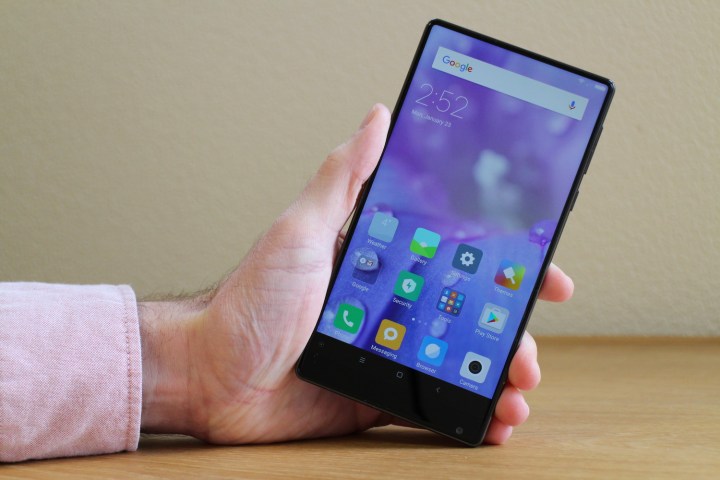A bezel is the name of the frame around displays, like those on your TV or smartphone. TV and computer monitor manufacturers have long been shaving down these edges to offer frame-less designs, and it looks like the smartphone bezel may soon become an endangered component as well. In the quest to give us bigger and better screens without creating clownishly huge phones, manufacturers have the bezel firmly in their sights.
Talk of a bezel-less phone has been swirling in recent months, and the screen-to-body ratio has been steadily climbing in many of the top new releases. The bezel-less look is distinctly futuristic and, despite some compromises, we are creeping inexorably toward it. We decided to compare some of the top phones to see who can boast the smallest bezels right now.
Here they are, ranked from the thinnest bezels to the thickest. Jump to our table at the bottom to see how all of them compare side by side. You may notice that our results vary from what the manufacturers report, but that’s because we always use the same formula to calculate it and they don’t.
Huawei P30 Pro
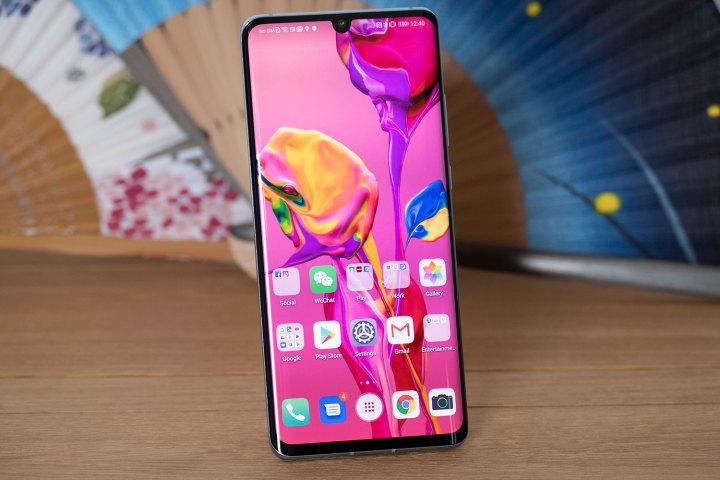
- Screen-to-body ratio: 88.5%
- Screen size: 6.47 inches
Huawei has managed to pack a huge screen into a comparatively sleek body with the P30 Pro and the 6.47-inch display has an aspect ratio of 19.5:9 with a teardrop notch carved out of the top and a sliver of thin bezel at the bottom. It scores a screen-to-body ratio of 88.5%. While it is an OLED screen, it doesn’t quite match the resolution of some of the other top devices, so it isn’t quite as sharp at 398 pixels per inch (ppi). However, the P30 Pro is an incredibly powerful phone with bags of battery life, a versatile camera suite, and lots of extras. It’s just a shame that it’s not officially available in the states.
OnePlus 7 Pro

- Screen-to-body ratio: 88.4%
- Screen size: 6.67 inches
The absolutely stunning OnePlus 7 Pro features a truly minimal design that includes a pop-up front-facing camera, which allows for an almost all-screen front — there’s still a bottom bezel. That enormous 6.67-inch screen is also incredibly sharp, with the deep blacks that AMOLED affords, and it boasts a silky smooth refresh rate of 90Hz. There’s also an in-display fingerprint sensor. Throw in a speedy Snapdragon 855 processor, loads of RAM and storage, and a triple-lens main camera, and you have a compelling phone, though it’s not as affordable as previous OnePlus releases.
Asus Zenfone 6
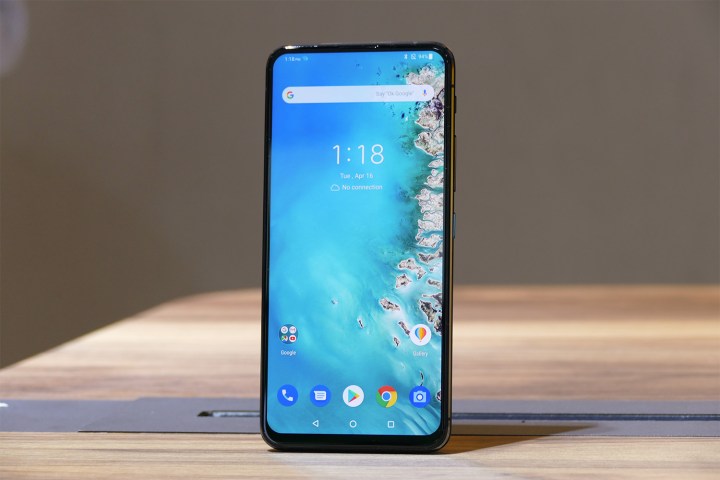
- Screen-to-body ratio: 83.7%
- Screen size: 6.4 inches
Asus has taken a different approach to everyone else by developing a motorized flip up camera that allows the front to be almost entirely screen and lets you use the main camera, which pairs 48-megapixel and 13-megapixel lenses, as your selfie camera. There is still a bezel at the bottom of the 6.4-inch screen and it’s an LCD with 403 pixels per inch, so it’s not the best display around. Internal specs are beefy with a Snapdragon 855, a massive battery, plenty of RAM and storage, and room for dual SIM and MicroSD card slots. It’s an unusual design, but the affordable price makes it tempting.
Samsung Galaxy S10, S10 Plus, and S10e
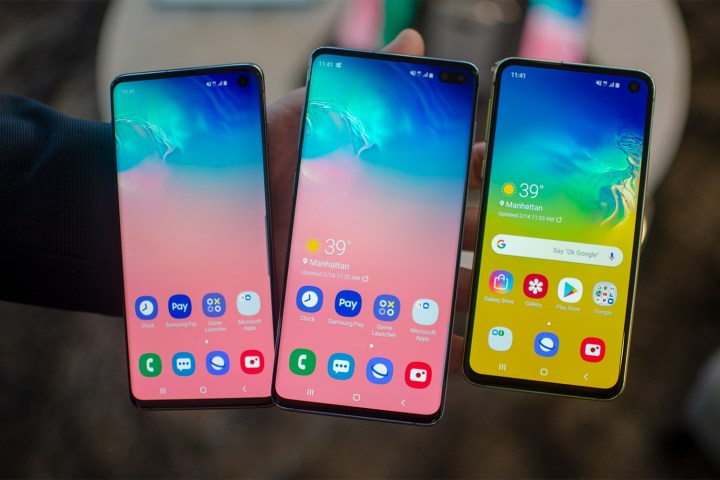
- Screen-to-body ratio: 88%, 87.5%, and 84.5%, respectively
- Screen size: 6.1 inches, 6.4 inches, and 5.8 inches, respectively
The 10th anniversary of Samsung’s Galaxy S range demanded something special, and the S10 lineup does not disappoint. With Infinity-O displays sporting hole-punch cameras, Samsung has eliminated even more bezel and crept closer to that elusive all-screen front. The S10 manages the top screen-to-body ratio at just over 88%, but the S10 Plus is not far behind. Samsung also removed the fingerprint scanner from the back and replaced it with an ultrasonic in-display fingerprint scanner. The Dynamic AMOLED screens in these phones are unbeatable, with accurate colors, intense brightness, and HDR10 Plus certification. The bar has been raised.
Huawei Mate 20 and Mate 20 Pro

- Screen-to-body ratio: 88% and 86.9%, respectively
- Screen size: 6.53 inches and 6.39 inches, respectively
The Huawei Mate 20 Pro is virtually unbeatable in the specs department, but that notch knocks into second place when it comes to screen-to-body ratio. Top spot is claimed by its sibling, the Huawei Mate 20, for now at least. With a teardrop notch and a tiny bottom bezel, the Huawei Mate 20 is almost all-screen on the front. It boasts many of the same features as its more expensive partner, but it is slightly larger, lacks wireless charging, and has a lower resolution display. While the Mate 20 has a traditional fingerprint sensor on the back, the Mate 20 Pro has an in-display fingerprint sensor. Sadly, neither phone is officially on sale in the U.S. If you want to import, the Mate 20 Pro will set you back around $900, while the Mate 20 is a couple of hundred dollars cheaper.
Oppo Find X
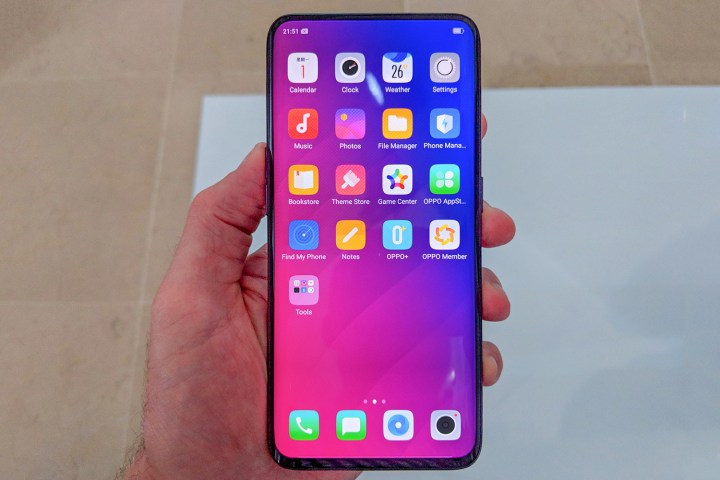
- Screen-to-body ratio: 86.9%
- Screen size: 6.42 inches
This stunning, glossy beauty comes close to an all-screen front. The huge 6.42-inch AMOLED screen has virtually no bezels, just a slim chin at the bottom; the back is a shiny expanse with no camera bump in sight. The camera array is motorized, and it only rises up when you tap the camera icon, taking 0.5 seconds to complete its journey. Once deployed, you have a 25-megapixel front-facing camera and the unfortunately named O-Face facial-recognition system facing you and a dual 16-megapixel and 20-megapixel rear camera. It’s an innovative approach that allows for a very minimalist design. Oppo promises the mechanism is hardy, but we do expect it to collect grime, which also means the phone isn’t water resistant. The Oppo Find X also packs cutting-edge specs, but it costs upwards of $1,000.
Vivo Nex S

- Screen-to-body ratio: 86.2%
- Screen size: 6.59 inches
Vivo, a pioneer of the pop-up camera concept as a way to increase a phone’s screen-to-body ratio without the need for a notch, showed off a concept phone at Mobile World Congress. But the Vivo Nex S is a real product that you can buy, though you’ll probably have to import it from China if you want one. It looks pretty conventional on the back, with a dual camera module that pairs a 12-megapixel and 5-megapixel lens, but the front is mostly screen with a tiny chin at the bottom. There’s an 8-megapixel, pop-up selfie camera at the top left. The Vivo Nex also boasts an in-display fingerprint sensor and technology that uses the display itself as a speaker. It’s an innovative package, though it lacks water-resistance, wireless charging, and NFC for payments. The price is around $700.
Honor View 20

- Screen-to-body ratio: 85.6%
- Screen size: 6.4 inches
The Honor View 20 has a hole punch camera at the top left of its IPS LCD display and a chin at the bottom. The 6.4-inch screen has an aspect ratio of 19.5:9. It features a beautiful design on the back, too, with an eye-catching reflective V pattern in the glass. There’s a whopping 48-megapixel camera in this phone, and it’s a zippy performer, which is all the more impressive when you consider the reasonable price tag.
Honor
OnePlus 6T
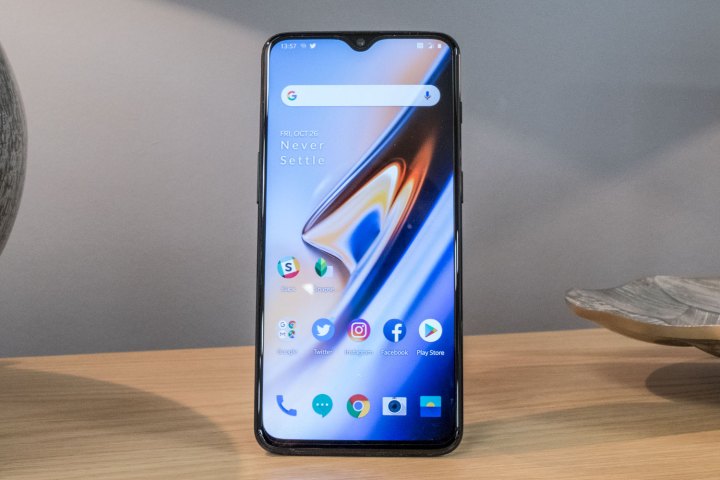
- Screen-to-body ratio: 85.5%
- Screen size: 6.41 inches
The OnePlus 6T matches much more expensive phones in terms of features and design. In fact, it has one of the best designs we’ve seen in 2018, with a slim bezel at the bottom of the display and a teardrop notch for the front-facing camera. The fingerprint sensor is part of the display. That screen is a 6.41-inch AMOLED with a 2,340 x 1,080-pixel resolution and a 19.5:9 aspect ratio. The performance is up there with the best Android phones, but the camera doesn’t quite match up and there’s no wireless charging support. Still, for $550 you won’t find a better phone.
Xiaomi Mi 9 and Mi Mix 3

- Screen-to-body ratio: 85.1% and 84.9%, respectively
- Screen size: 6.39 inches and 6.39 inches, respectively
These two Xiaomi phones may look very similar on paper, but the Mi 9 has a teardrop notch for the front-facing camera, while the Mi Mix 3 goes with a mechanical pop-up camera. Both sport stunning AMOLED displays, though they aren’t as sharp as many other flagships. The internal specs are impressive and the Mi 9, in particular, is very good-looking and packs the Snapdragon 855. The software and camera performance can be weak spots for Xiaomi phones, but you may accept some compromises when you see the relatively low prices.
Essential PH-1
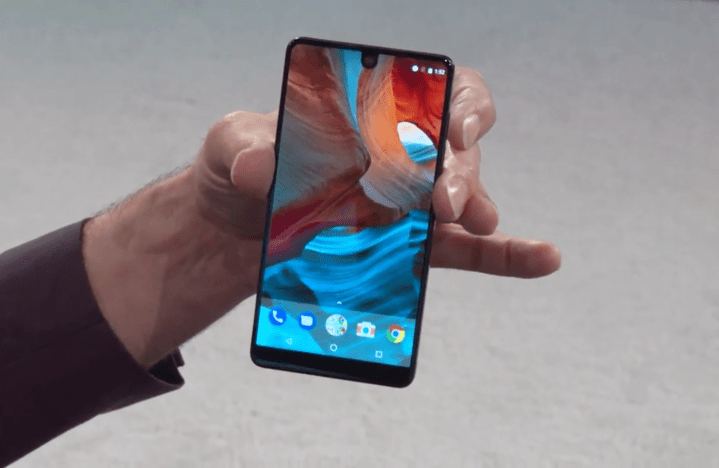
- Screen-to-body ratio: 84.9%
- Screen size: 5.71 inches
The Essential PH-1 from Android co-creator Andy Rubin’s company instantly won praise for its edge-to-edge screen design. For a long time, this was as close as we’d gotten to the front of a phone being entirely screen. You’ll find the thinnest of bezels on the sides and top of the screen, which has rounded corners, like the LG G6. There is still a fairly big bezel on the bottom, though it doesn’t visibly house anything — the fingerprint sensor is on the back. The Essential PH-1 raises an obvious design problem with bezel-less design — where does the front-facing camera go? The designers decided to include a curved dip at the top of the display that eats into the screen. It’s an interesting move that has divided opinion, but regardless of whether you like it or not, this smartphone ushered in a new design direction and a leap forward in terms of screen-to-body ratio.
Apple iPhone XS Max
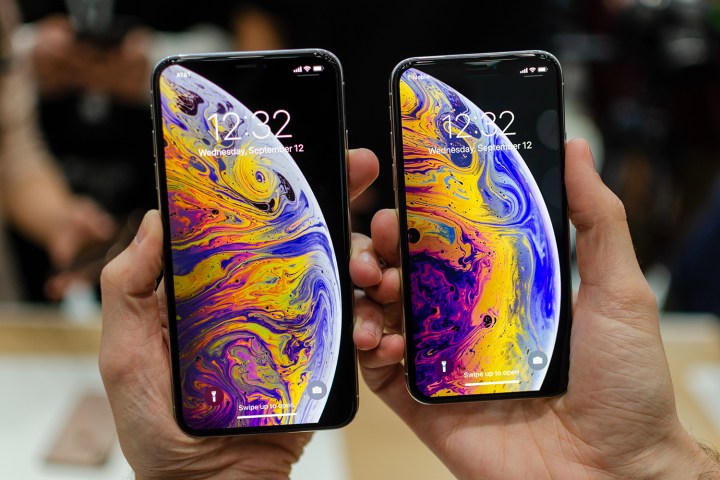
- Screen-to-body ratio: 84.4%
- Screen size: 6.5 inches
The iPhone XS Max sports the biggest screen we’ve ever seen in an iPhone and also boasts Apple’s highest screen-to-body ratio to date. The fact that this phone packs in a screen that’s a full inch bigger in the diagonal than the iPhone 8 Plus, yet comes in a smaller body, tells you a lot about the new edge-to-edge, notched display design that Apple has employed. It has that superwide 19.5:9 aspect ratio and the same OLED tech that graces all the best phones nowadays. The 2,688 x 1,242-pixel resolution also enables it to match the iPhone XS when it comes to sharpness, with a pixel-per-inch count of 458. The sizable notch prevents Apple’s biggest from climbing any higher in our chart, but it’s an impressive bid for bezel-less supremacy.
Honor 8X
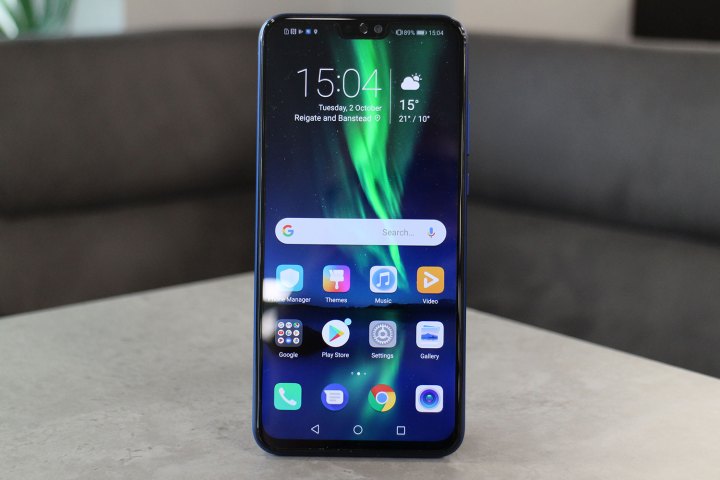
- Screen-to-body ratio: 84.3%
- Screen size: 6.5 inches
Last year’s Honor 7X was an impressive package for just $200 and we’re equally impressed with the sleek, colorful Honor 8X. Clearly, the bezel-killing design trend is alive and well at the midrange to the budget end of the market and this phone places impressively high on our list. It partly achieves such a high screen-to-body ratio by having a massive 6.5-inch display, another rarity in lower-priced phones. This is a big phone, with a 19.5:9 aspect ratio, and there is still a small chin at the bottom of the screen and a notch carved out of the top. The 2,340 x 1,080-pixel resolution is adequate and the specs are impressive for a device this stylish and affordable.
Honor
Samsung Galaxy S9, S9 Plus, and Note 9
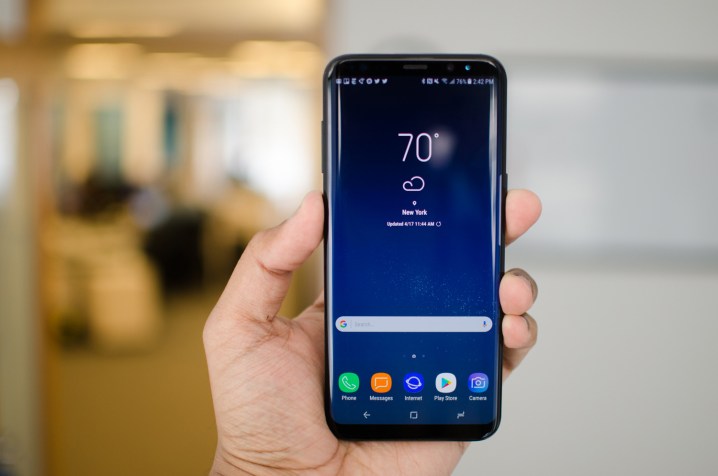
- Screen-to-body ratio: 83.6%, 84.2%, and 83.9%, respectively
- Screen size: 5.8 inches, 6.2 inches, and 6.4 inches, respectively
With a 5.8-inch curved “Infinity Display,” the Galaxy S9 is one of the best-looking phones on our list. Its bigger brother, the S9 Plus, actually boasts a slightly higher screen-to-body ratio with its 6.2-inch screen. There is still a thin bezel top and bottom, and an even slimmer one around the sides, though it’s not really noticeable when you look at the phone head-on because of those sloping edges. Samsung ditched the home button with the S8 and used Android’s standard navigation icons on the screen, so the bottom bezel is empty, but the top bezel still contains the iris scanner, proximity sensor, earpiece, and selfie camera. These are some of the biggest screens on the market, but they’re packed into svelte bodies — largely because of the 18.5:9 aspect ratio.
LG G8 ThinQ
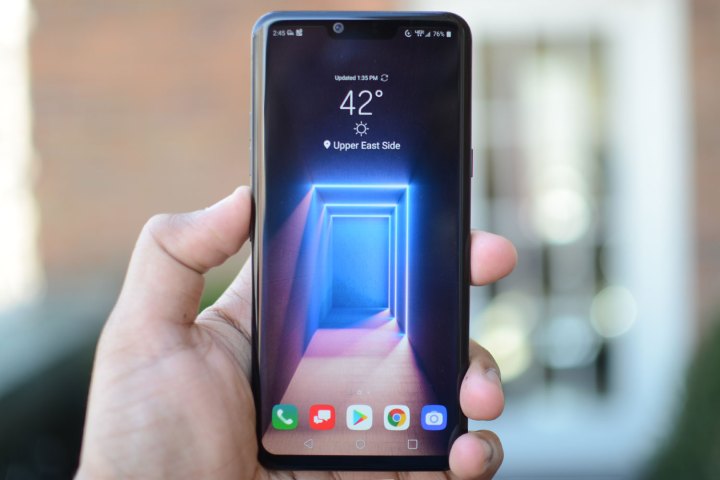
- Screen-to-body ratio: 83.6%
- Screen size: 6.1 inches
The LG G8 ThinQ is quite similar to last year’s G7, but LG has managed to slim the body down a bit to score a higher screen-to-body ratio of 83.6%. It has a 6-inch AMOLED screen with a shar 3,120 x 1,440-pixel resolution and 19.5:9 aspect ratio. There’s also a new front-facing camera with all sorts of tricks including gesture control and secure face unlock, and you’ll find a similar dual-lens camera to its predecessor on the back. There’s no earpiece, so audio comes from the Crystal Sound OLED screen and the Boombox speaker.
LG V50 ThinQ 5G and LG V40 ThinQ

- Screen-to-body ratio: 83.6%
- Screen size: 6.4 inches
LG embraced the notch and looks to be moving closer to an all-screen device with each release. The V40 ThinQ brought the notch to the V Series, but also retained a small chin under the screen, and the LG V50 ThinQ 5G sports the exact same design. These big phones have a 6.4-inch screen with a wide 19.5:9 aspect ratio and a 3,120 x 1,440-pixel resolution. Since it’s also an OLED screen, this is one of the best options around for fans of movies and games. You’ll also find five lenses in the cameras in these devices, three for the main camera and two for the front-facing camera, so the phones are a versatile choice for photography fans.
Asus Zenfone 5 and Zenfone 5Z
- Screen-to-body ratio: 83.6%
- Screen size: 6.2 inches
There’s no denying the resemblance to a certain Apple phone here, but Asus has actually managed to achieve a higher screen-to-body-ratio than the iPhone X because its notch is 26% smaller. The company claims it has a 90-% screen-to-body ratio, but by our calculations it’s actually 83.6%. The 19:9 aspect ratio has enabled Asus to pack this large screen into an impressively small body. There’s still a small bezel at the bottom, but this phone does look and feel very nice — and it comes in at half the price of the iPhone X. In fact, if you opt for the Zenfone 5 with its midrange processor, rather than the Snapdragon 845-toting 5Z, then it will cost you even less.
Xiaomi Mi Mix
- Screen-to-body ratio: 83.6%
- Screen size: 6.4 inches
You may not have heard of this huge phone, but if you have, it was almost certainly because of the edge-to-edge display. Xiaomi claimed a 91.3-% screen-to-body ratio, but when the phone landed, it turned out to have very thin black borders around the screen, on the sides and top, resulting in an actual body-to-screen ratio of 83.6%. It was still top of the charts at the time, and Xiaomi deserves credit for being in the bezel-less vanguard, but it has now been surpassed. Xiaomi “solved” the selfie camera conundrum by housing it in the fairly large bottom bezel, which is an awkward place to put it.
Apple iPhone X and iPhone XS

- Screen-to-body ratio: 82.9%
- Screen size: 5.8 inches
Apple’s special iPhone X (pronounced ten) has an almost all-screen design. It’s a gorgeous 5.8-inch OLED panel with curved corners and the thinnest of frames. Apple decided to include an indented notch at the top that’s packed with sensors, a speaker, microphone, and the front-facing camera. With a resolution of 2,436 x 1,125 pixels, this is the sharpest display we’ve ever seen in an iPhone. The Super Retina display actually has an aspect ratio of 19.5:9, which makes it the widest screen we’ve seen, but that cut-out at the top does eat into a portion of the picture. Apple got around the problem of removing the TouchID fingerprint sensor by replacing it with FaceID, which uses the front-facing camera to identify your face before unlocking. The iPhone XS features an identical design.
Apple Ebay
AT&T Sprint
T-Mobile Verizon
Pixel 3 XL
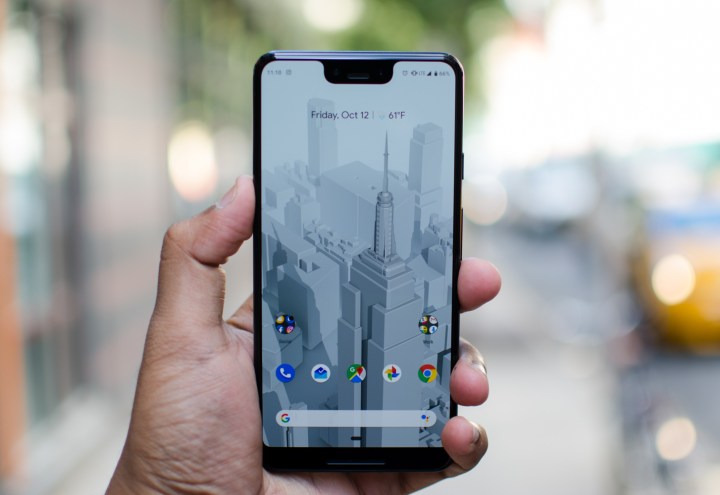
- Screen-to-body ratio: 82.8%
- Screen size: 6.3 inches
Though we’re not fans of the deep notch, Google has made progress against the bezel with the Pixel 3 XL. This 6.3-inch OLED screen has a resolution of 2,960 x 1,440 pixels and an 18.5:9 aspect ratio. This is Android as Google intended with some irresistible artificial intelligence software features thrown in and the best camera in a smartphone right now. The notch accommodates a dual lens front-facing camera capable of snapping wide selfies. There’s also room for dual front-facing speakers. The only real weakness of this phone is the mediocre battery life. If you want to snag one, then you’re looking at paying out $900.
Xiaomi Pocophone F1

- Screen-to-body ratio: 82.2%
- Screen size: 6.18 inches
The Pocophone F1 by Xiaomi offers a lot for somewhere around $300, though you’ll have to import it if you live in the U.S. or U.K. It has an IPS LCD screen that’s 6.18 inches in the diagonal. The respectable 2,246 x 1.080-pixel resolution translates to 403 ppi, and there’s an 18.7:9 aspect ratio. The deep notch digs into the display and there’s also a bezel at the bottom, but the screen-to-body ratio is impressive for a budget phone.
Sony Xperia 1, Xperia 10, and 10 Plus
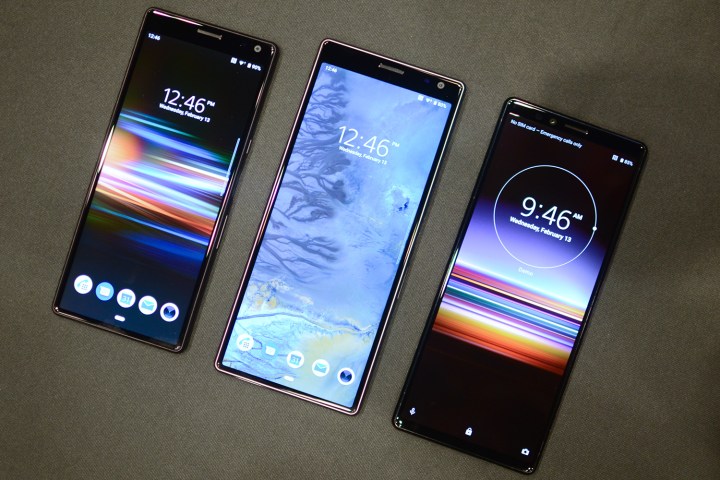
- Screen-to-body ratio: 81.9%, 79.5%, and 81%, respectively
- Screen size: 6.5 inches, 6 inches, and 6.5 inches, respectively
While Sony has resisted the bezel-less bandwagon, it has shrunk the bezels down significantly in its latest trio of phones, while also elongating the screens. These tall devices have a 21:9 aspect ratio, which makes them perfect for watching movies on. While the Xperia 10 and 10 Plus make do with IPS LCD screens, the Xperia 1 boasts a gorgeous OLED screen with all of Sony’s picture-processing smarts behind it. These phones still have a fairly big top bezel with a speaker and camera in it, but the sides and bottom edge have been slimmed down.
Moto G7

- Screen-to-body ratio: 81.4%
- Screen size: 6.2 inches
The budget G series shows how design trends in more expensive smartphones are fairly quick to filter down. This is a $300 device with a 6-inch IPS LCD that has a teardrop notch to accommodate the front-facing camera. There’s still quite a big chin at the bottom and bezels around the sides, but this is a high screen-to-body ratio for a budget phone. The curves, which extend to the glass back, give it a fairly classy look and feel.
Sony Xperia XZ3

- Screen-to-body ratio: 80.5%
- Screen size: 6 inches
Sony has refined its Xperia design in the XZ3, and this marks the first time is has adopted superior OLED technology in a smartphone. There are still bezels top and bottom, but the 6-inch display sports an impressive 2,880 x 1,440-pixel resolution for a sharp 537 ppi rating. It’s a standard 18:9 aspect ratio. Sony still has a ways to go, but it has shaved off some extra bezel compared to the XZ2, and the curved edges and OLED tech make this its best screen design yet.
HTC U12 Plus

- Screen-to-body ratio: 80.3%
- Screen size: 6 inches
There’s no doubt that HTC has been working on slimming down the bezels, because the U12 Plus has a much higher screen-to-body ratio than the U11 Plus or the U11. Packing a 6-inch, 2,880 x 1,440-pixel Super LCD screen, this phone has a slimmer frame all around. This was partly achieved by shifting the fingerprint sensor around the back, instead of including a lozenge-shaped sensor at the bottom of the screen, like the U11. The U12 Plus also features solid flagship specs, but the digital buttons don’t work as well as they should.
Nokia 9 PureView
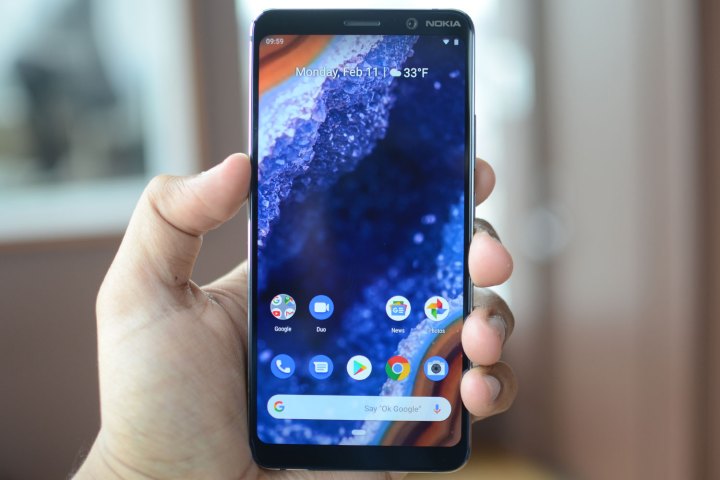
- Screen-to-body ratio: 79.6%
- Screen size: 5.99 inches
Instead of a notch or a hole-punch camera, the Nokia 9 PureView has a more traditional look with a bezel top and bottom. The 5.99-inch OLED screen has a familiar 18:9 aspect ratio, but it’s plenty sharp and the build quality of this phone is excellent. There’s an in-display fingerprint scanner here as well. The truly eye-popping thing about this phone is the five camera lenses on the back. This multi-camera technology was developed in partnership with Light and promises impressive performance.
Nokia 7.1
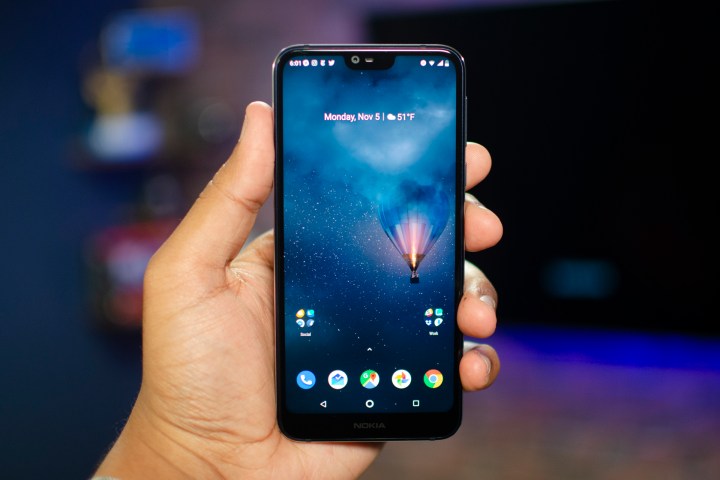
- Screen-to-body ratio: 79.6%
- Screen size: 5.84 inches
With a small notch and a fairly large bottom bezel, the Nokia 7.1 still charts well, especially considering it only costs $350. The 5.84-inch display has a 2,280 x 1,080-pixel resolution with a 19:9 aspect ratio. It’s an Android One phone, which contributes to the reasonably slick performance, and also means it will receive swift Android updates. There is a capable camera here, too, but battery life could be better. Manufacturer HMD Global is clearly taking note of design trends and we’re impressed with the look and feel of the Nokia 7.1.
Apple iPhone XR

- Screen-to-body ratio: 79%
- Screen size: 6.1 inches
The most affordable of Apple’s new notch-toting trio is the iPhone XR, but Apple has definitely made some compromises in the display and design department to keep that price down. This is a 6.1-inch screen with the same 19.5:9 aspect ratio as its siblings, however the XR has an LCD screen instead of OLED and the resolution is 1,792 x 828 pixels, which matches the sharpness of the iPhone 8 at 326 ppi. It has the same notch as the iPhone X, XS, and XS Max, but the XR clearly has bigger bezels around its display and as a consequence it fails to beat a bunch of phones with more traditional big bezels top and bottom.
Google Pixel 3

- Screen-to-body ratio: 77.2%
- Screen size: 5.5 inches
It may be our favorite Android phone and the best camera phone available right now, but the Pixel 3 lags behind the field with its bezel game. There’s a 5.5-inch display with a resolution of 2,160 x 1,080 pixels and an 18:9 aspect ratio. As you can see, it still has big bezels top and bottom, though that does allow for front-facing speakers and the dual front-facing camera system. You’ll find the fingerprint sensor around back. Compared to last year’s Pixel 2, this is a major improvement, but it doesn’t come close to the latest designs from other manufacturers.
Apple iPhone 8 and 8 Plus
- Screen-to-body ratio: 65.6% and 67.7%, respectively
- Screen size: 4.7 inches and 5.5 inches, respectively
In general, the smaller the screen, the lower the screen-to-body ratio, and so it’s not a big surprise that the iPhone 8 has the lowest screen-to-body ratio on the list. However, even the 8 Plus, with its much bigger display, has big bezels. The round, recessed Touch ID demands a lot of room at the bottom and that seems to be matched by a thick band at the top, which only houses the small front-facing camera, earpiece, and sensors. Both Phones also have noticeably bigger side bezels around the screen than their competitors, but they may be the last big bezels we see from Apple in light of the notch trend.
Table for comparison at-a-glance
| Phone | Screen size | Aspect ratio | Screen-to-body Ratio |
| Huawei P30 Pro | 6.47 inches | 19.5:9 | 88.5% |
| OnePlus 7 Pro | 6.67 inches | 19.5:9 | 88.4% |
| Asus Zenfone 6 | 6.4 inches | 19.5:9 | 83.7% |
| Samsung Galaxy S10 | 6.1 inches | 19:9 | 88% |
| Huawei Mate 20 | 6.53 inches | 18.7:9 | 88% |
| Samsung Galaxy S10 Plus | 6.4 inches | 19:9 | 87.5% |
| Oppo Find X | 6.42 inches | 19.5:9 | 86.9% |
| Huawei Mate 20 Pro | 6.39 inches | 19.5:9 | 86.9% |
| Vivo Nex S | 6.59 inches | 19.3:9 | 86.2% |
| Honor View 20 | 6.4 inches | 19.5:9 | 85.6% |
| OnePlus 6T | 6.41 inches | 19.5:9 | 85.5% |
| Xiaomi Mi 9 | 6.39 inches | 19.5:9 | 85.1% |
| Xiaomi Mi Mix 3 | 6.39 inches | 19.5:9 | 84.9% |
| Essential PH-1 | 5.71 inches | 19:10 | 84.9% |
| Samsung Galaxy S10e | 5.8 inches | 19:9 | 84.5% |
| Apple iPhone XS Max | 6.5 inches | 19.5:9 | 84.4% |
| Honor 8X | 6.5 inches | 19.5:9 | 84.3% |
| Samsung Galaxy S9 Plus | 6.2 inches | 18.5:9 | 84.2% |
| Samsung Galaxy Note 9 | 6.4 inches | 18.5:9 | 83.9% |
| OnePlus 6 | 6.28 inches | 19:9 | 83.8% |
| LG G8 ThinQ | 6.1 inches | 19.5:9 | 83.6% |
| LG V50 ThinQ 5G | 6.4 inches | 19.5:9 | 83.6% |
| LG V40 ThinQ | 6.4 inches | 19.5:9 | 83.6% |
| Samsung Galaxy S9 | 5.8 inches | 18.5:9 | 83.6% |
| Asus Zenfone 5 or 5Z | 6.2 inches | 19:9 | 83.6% |
| Xiaomi Mi Mix | 6.2 inches | 17:9 | 83.6% |
| Apple iPhone X and XS | 5.8 inches | 19.5:9 | 82.9% |
| Google Pixel 3 XL | 6.3 inches | 18.5:9 | 82.8% |
| LG G7 ThinQ | 6.1 inches | 19.5:9 | 82.6% |
| Xiaomi Pocophone F1 | 6.18 inches | 18.7:9 | 82.2% |
| Huawei P20 Pro | 6.1 inches | 18.7:9 | 82% |
| Sony Xperia 1 | 6.5 inches | 21:9 | 81.9% |
| Xiaomi Mi Mix 2S | 5.99 inches | 18:9 | 81.9% |
| Moto G7 | 6.2 inches | 19:9 | 81.4% |
| LG V30 and V35 ThinQ | 6 inches | 18:9 | 81.2% |
| Nokia 8 Sirocco | 5.5 inches | 16:9 | 81.1% |
| Sony Xperia 10 Plus | 6.5 inches | 21:9 | 81% |
| Xiaomi Mi Mix 2 | 5.99 inches | 18:9 | 80.8% |
| Sony Xperia XZ3 | 6 inches | 18:9 | 80.5% |
| HTC U12 Plus | 6 inches | 18:9 | 80.3% |
| Nokia 9 PureView | 5.99 inches | 18:9 | 79.6% |
| Nokia 7.1 | 5.84 inches | 19:9 | 79.6% |
| Sony Xperia 10 | 6 inches | 21:9 | 79.5% |
| Apple iPhone XR | 6.1 inches | 19.5:9 | 79% |
| Google Pixel 3 | 5.5 inches | 18:9 | 77.2% |
| Honor 7X | 5.93 inches | 18:9 | 77% |
| Google Pixel 2 XL | 6 inches | 18:9 | 76.4% |
| Sony Xperia XZ2 | 5.7 inches | 18:9 | 76.1% |
| Moto G6 | 5.7 inches | 18:9 | 75.4% |
| Moto G6 Plus | 5.9 inches | 18:9 | 74.4% |
| Nokia 6.1 | 5.5 inches | 16:9 | 73.2% |
| Google Pixel 2 | 5 inches | 16:9 | 67.9% |
| Apple iPhone 8 Plus | 5.5 inches | 16:9 | 67.7% |
| Apple iPhone 8 | 4.7 inches | 16:9 | 65.6% |

